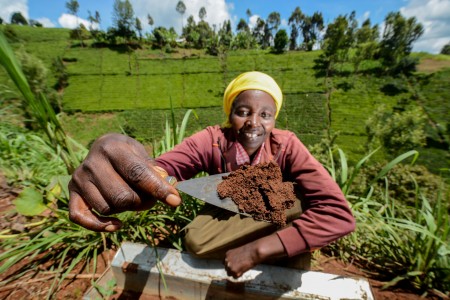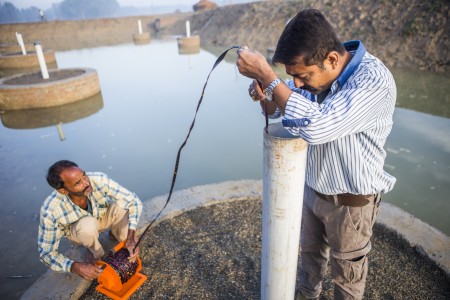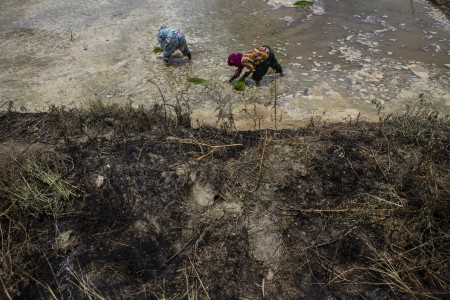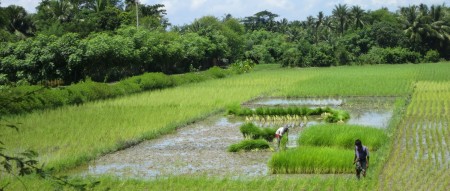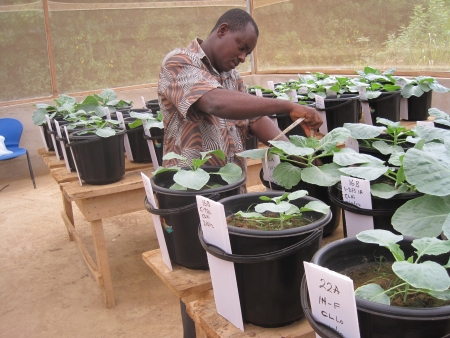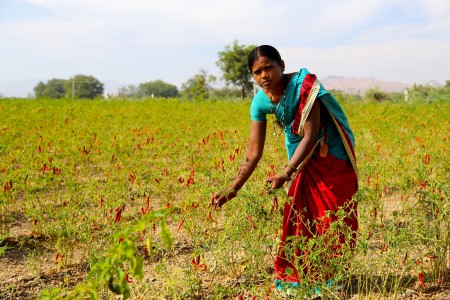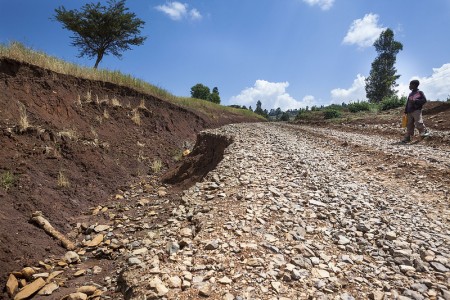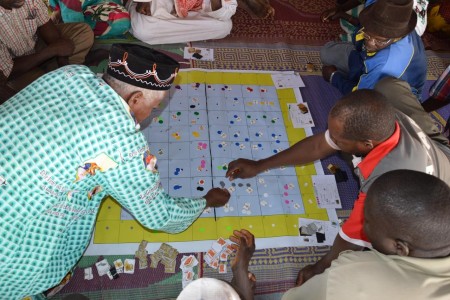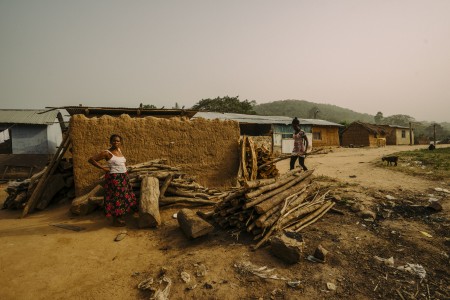The WLE 2016 Annual Report > Influencing policy and decision making

Curbing land degradation for livelihoods and climate change adaptation
Farmer Rachael Njeri lives in the middle of the Tana River Basin in central Kenya. She collects soil samples that are used to build up a bigger picture of how poor land management causes soil erosion, which in turn is clogging up the Tana River.
The Tana River is important because it supplies water to the majority of people in Nairobi, as well as to big businesses downstream, like Coca Cola. It is also used to generate most of the electricity used by Nairobi. Therefore, improved soil health upstream can have big benefits for those living downstream.
Best bets for soil restoration
Rachael is working with researchers of the International Center for Tropical Agriculture (CIAT). They are investigating how to improve the flow of water in the Tana River by advising on which agricultural management practices farmers can use to reduce soil erosion and even boost harvests.
For example, Rachael has started growing forage strips on her sloping land, which prevent soil erosion and provide feed for her cattle. “When I planted the Napier grass, the water was trapped. Now more soils stay at the top of the farm,” said Rachael. Capturing water and topsoil both boosts agricultural productivity locally and improves water quality downstream.
CIAT is implementing this work as part of its contribution the Tana-Nairobi Water Fund, coordinated by the Nature Conservancy. This is the first water fund for Africa, and it unites water users along the watershed, leveraging big businesses to finance protection measures carried out by users upstream – farmers like Rachel.
Aiming to make information about promising soil health restoration methods widely available, CIAT has published a Soils Best Bets compendium. It is a detailed guide to the various methods and practices, such as planting grasses on sloping land, which can be used to maintain, or increase, the organic matter and fertility of soils. The compendium also details how suitable each option is for different geographies and agro-ecologies.
Tools for tailoring and targeting soil restoration efforts
Acknowledging the benefits of healthy soils, many governments and non-governmental organizations are striving to combat land degradation, but one frequent challenge is a lack of data on existing soil conditions.
WLE researchers, including those from the World Agroforestry Centre (ICRAF) and the International Potato Center (CIP), have been developing a range of tools to overcome this issue.
ICRAF has helped set up Soil-Plant Spectral Diagnostic Labs in 10 African countries. They are collaborating with scientists in Ethiopia, Ghana, Nigeria and Tanzania to prepare soil health baselines as part of the Africa Soil Information Service (AfSIS), the most comprehensive soil sample database available for Africa, with over 28,000 sampling locations by the close of 2016.
Researchers of ICRAF have also contributed to the infrared and x-ray spectroscopy methodology used by AfSIS, which costs much less than conventional soil and plant analysis techniques. Similar technologies have been piloted by researchers of CIP, who have developed a portable device that uses laser-induced optical techniques, making it possible to measure, monitor and verify soil carbon levels in the field.
There is growing evidence that some donors and governments in Africa are using these tools to map soil fertility problems, target soil conservation efforts and measure soil carbon stocks. For example, the Ethiopian Soil Information System (EthioSIS) has produced soil fertility atlases for all regions. They are being used to shape interventions in Ethiopia’s second Growth and Transformation Plan (GTP II) Agricultural Transformation Agenda to improve fertilizer use efficiency.
Capturing carbon in soils for climate change mitigation
Finally, while soil health is a prerequisite for long-term, sustainable agricultural productivity, it can also contribute to climate change mitigation.
Recent analysis shows that agricultural lands could be turned into a carbon sink, absorbing between 0.9 and 1.85 gigatons of carbon per year – equal to about 6 to 13% of all human-induced carbon emissions – on the 16 million km2 of agricultural land globally.
To aid decision makers and investors to understand where investments in soil restoration could result in climate change mitigation benefits, researchers have developed a Soil Organic Carbon App. This app can help users calculate the capacity of a soil to store - or sequester - organic carbon.
Stemming soil and land degradation has the potential to improve agricultural productivity, food security and help in efforts to mitigate climate change, but success depends on selecting the right solutions for the context, providing incentives and removing institutional barriers.
Learn more about what WLE is doing to promote healthy soils for more productive agriculture.
Towards sustainable intensification:
stories of real-world sciencewater, land and ecosystems research highlights
Phase 1
Since its inception in 2012, the CGIAR Research Program on Water, Land and Ecosystem (WLE) has developed scientific evidence and solutions for sustainably intensifying agriculture.
For WLE, sustainable intensification means more than minimizing agriculture’s environmental footprint; it means making sure that agriculture benefits both the planet and its people, providing global populations with food and nutritional security, resilience and livelihoods.
WLE researchers and their partners work across scales, disciplines and sectors to find sustainable, viable ways to transform agriculture, locally and at scale. Discover how the resulting solutions can lead to real-world change by exploring the briefs and stories below to.
New briefs on sustainable intensification
Achieving resilient food systems requires identifying incentives for sustainable farming, developing new policies and institutions, as well as working with diverse stakeholders to test and scale integrated solutions.
The program’s findings so far are summarized in a new series of briefs, Towards sustainable intensification: Insights and solutions.
The series aims to guide and support decision and policy makers, investors and others working to achieve sustainable intensification of agriculture. Each brief is focused on a topic of strategic relevance and provides analysis of and recommendations on how to place sustainability at the heart of agri-food systems.
in 2015 wle: field tested 62 technologies and natural resource management practices, helped 125,000 farmers to apply new technologies or management practices, supported improved technologies or management practices on 2.5 million hectares
Influencing policy and decision making
In 2015 WLE: established 41 multi-stakeholder platforms and influenced 200 policy processes
Promoting innovative business models and institutions
Facilitating community-led science
WLE in 2015 had 110,000 website visits and 43,000 views on CG-space and published 141 ISI publications and 94 open access publications




